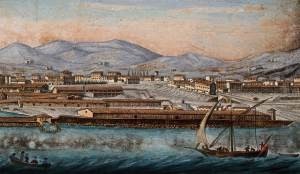
 The lazaretto at Livorno, Tuscany, Italy: panoramic view. Coloured etching by P. Lapi, 1824, Wellcome Library.
The lazaretto at Livorno, Tuscany, Italy: panoramic view. Coloured etching by P. Lapi, 1824, Wellcome Library.
Yellow fever is an infectious disease of viral origin, endemic to tropical areas of Africa, whose main symptoms are high fever, abundant and black vomiting and jaundice. It was transported to the Caribbean world at the beginning of the modern era and then, from the 18th century to Europe, through triangular trade. In 1800, it appeared in the south of Spain, which alerted the Italian health magistrates who, haunted by the traumatic memory of the plague pandemics, put in place drastic measures to control ships passing through Iberian ports. Italy was extremely fragmented at the time. In the north of the country, the main states are dominated by France: the Ligurian Republic (region of Genoa), the Italian Republic (regions of Milan and Bologna), the Kingdom of Etruria (region of Florence). On the other hand, the south of Italy partially escapes from the Napoleonic influence, whether it is the Papal States (region of Rome) or the Kingdom of Naples. However, the measures adopted were relatively uniform in all States and, when the epidemic seemed to slow down, sanitary precautions were reduced everywhere and trade gradually resumed between the two peninsulas.
At the end of the summer of 1804, a doctor called to a tavern in Livorno, in the Kingdom of Etruria, found Spanish sailors coming from Cadiz, overwhelmed by a terrible disease, which quickly killed them all. He diagnosed yellow fever and warned the authorities, but the governor of the city ordered him to remain silent. The spread of this new represented a major risk for the city: a quarantine would deprive it of most of its income. Moreover, the identity of the whistleblower makes his word doubtful: Brignole is of Genoese origin, but Genoa and Livorno maintain a long-standing commercial rivalry. However, the governor did not manage to contain either the disease or the rumors: the fever continued to kill, and at the end of September, emergency sanitary measures were adopted throughout Italy. Firstly, the neighbours of the Kingdom of Etruria isolate the infected territory by a militarized cordon sanitaire. Then, Livorno was isolated from the rest of the Kingdom of Etruria by its army.
This political uniformity contrasts with the diversity of scientific positions. The doctors in Lucca say that Livorno fever is yellow fever, contagious and epidemic and that it is a threat as dangerous as the Plague — a globally shared analysis in Genoa and Milan. On the contrary, Roman doctors are more circumspect and only gradually rally to the theory of yellow fever, without being convinced of its contagiousness. At the same time, the Kingdom of Etruria carefully avoided calling it “yellow fever” at the time of the epidemic, but also the following year. Moreover, the Republic of Lucca initially decrees very rigorous control measures, in accordance with the risk assessed by its doctors, but quickly relaxes them while the medical reports do not change. Conversely, the Papal States establish a stricter cord than the Republic of Lucca, although its official scientific position is less alarming.
These elements show that public health is much more a political issue than a scientific one. From the beginning of the epidemic, the Ligurian Republic deployed an intense diplomatic activity to attribute responsibility to the Kingdom of Etruria and toughen the sanctions. Genoa sends an ultimatum to the other Italian states: those who do not quarantine Tuscan merchandises will be embargoed. In this perspective, the policy of the Papal States mixes the precautionary principle and economic interests: whatever the nature of the disease, the cordon sanitaire cannot harm health. Moreover, while it represents a significant financial cost, it makes it possible to maintain trade relations with northern Italy. On the contrary, the small Republic of Lucca, unable militarily and economically to maintain a strict cordon over time, rapidly alleviates its health measures, although its doctors continue to describe the situation as critical.
The yellow fever epidemic in Livorno shows the interweaving of political, medical and economic issues. Behind the apparent uniformity of health measures, a great diversity of interests and logic is at work. The national particularities that emerge after a few weeks are not explained by mere intellectual differences: they are due to the variable material capacities of each country as well as their economic interests.
Read more in the dictionary : Barcelona 1821
Read the paper in French : Livourne 1804
Références :
Samuel Fettah, Les limites de la cité. Espace, pouvoir et société à Livourne au temps du port franc, XVIIe-XIXe siècles, École française de Rome, 2017.
Jean Boutier, Sandro Landi et Olivier Rouchon (dir.), Florence et la Toscane, XIVe-XIXe siècles. Les dynamiques d’un État italien, Presses Universitaires de Rennes, 2004.
To quote this paper : Paul-Arthur Tortosa, "Livorno 1804" in Hervé Guillemain (ed.), DicoPolHiS, Le Mans Université, 2022.